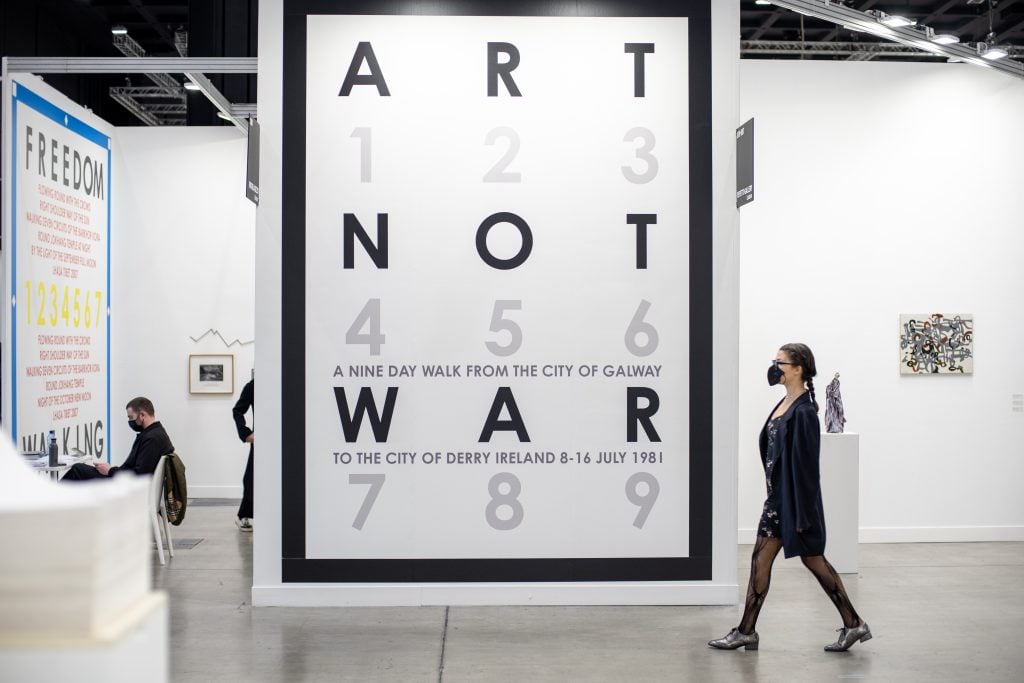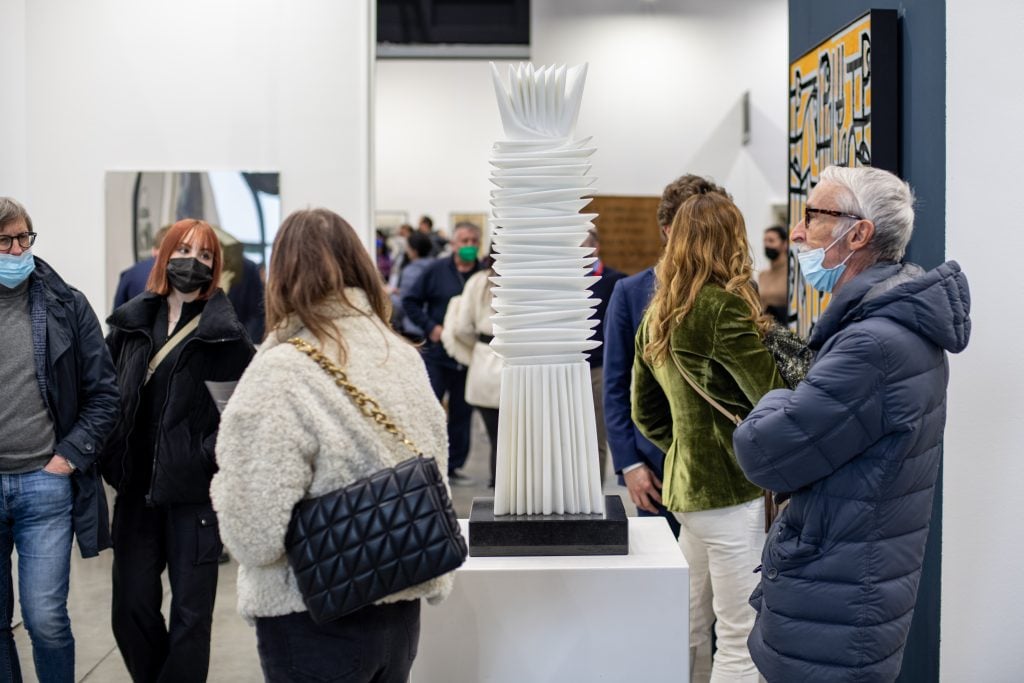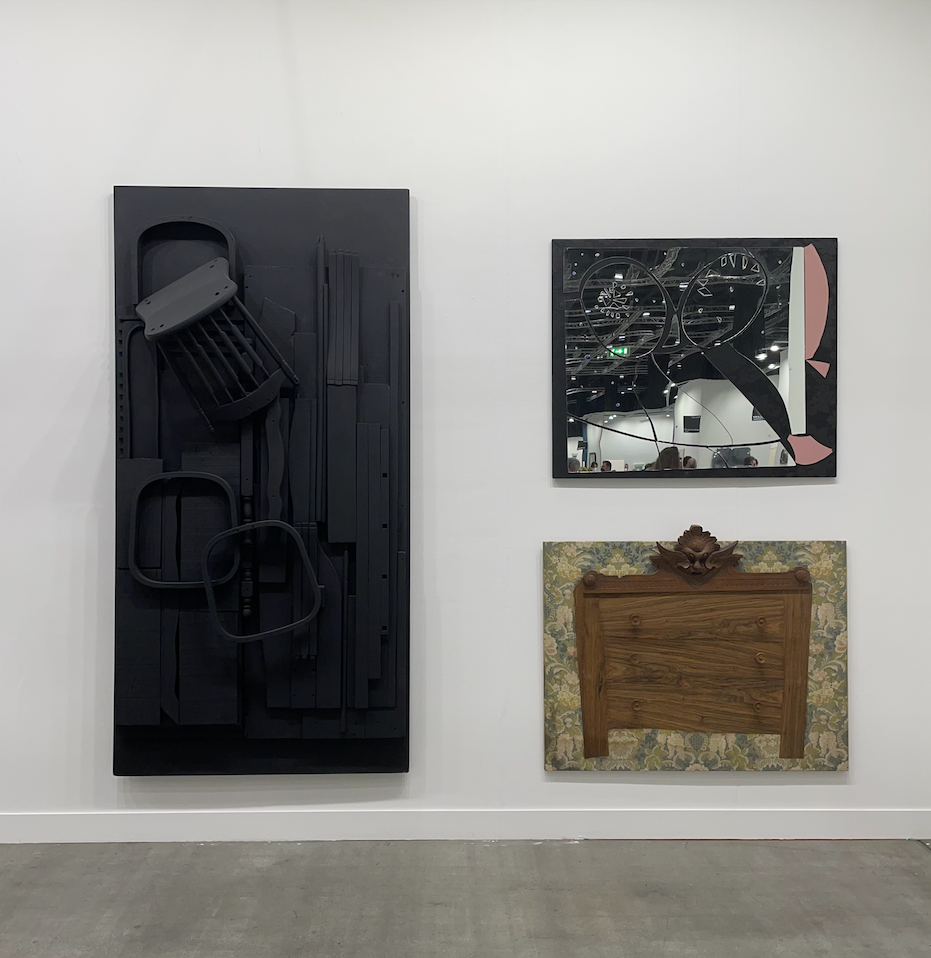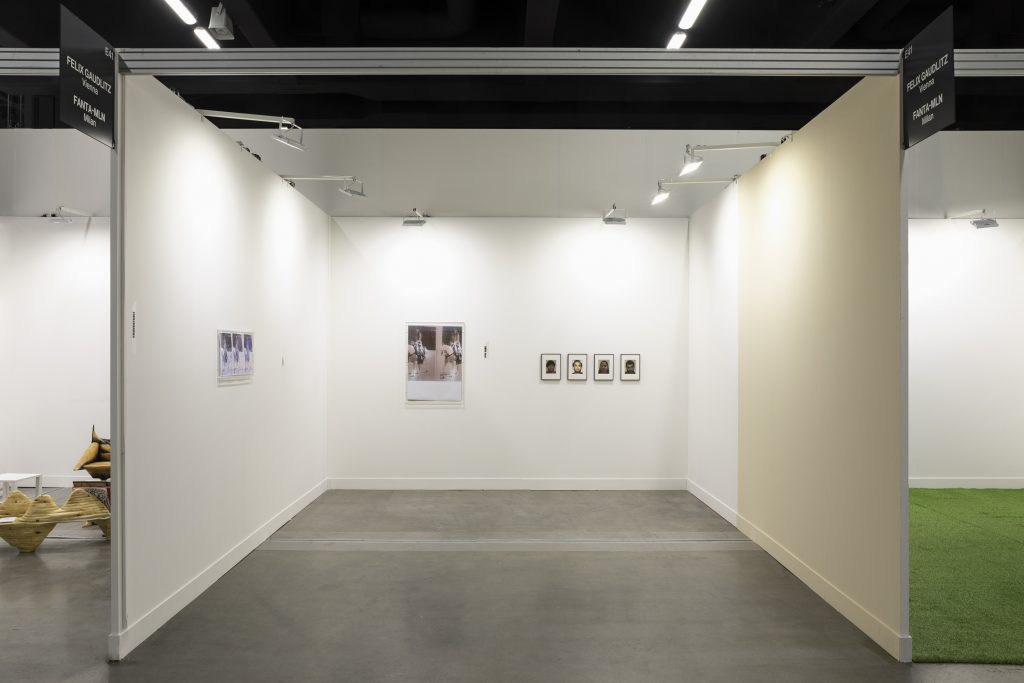Artnet News Pro
Miart Makes a Big Return as Lockdown Lifts in Italy. Insiders Say It Now Needs Young Collectors
There's a lot at stake for Milan as its flagship fair charts a course.

There's a lot at stake for Milan as its flagship fair charts a course.

Vivienne Chow

Laughter and chatter lingered in the jam-packed exhibition hall of the Milano Convention Centre during the VIP night of miart last week. The atmosphere distinctly felt as if the well-dressed crowd donning colorful KN95 face masks was gathered to celebrate something bigger than the opening of an art fair.
In fact, it was the last night of a state of emergency in Italy that had lasted for more than two years, with the country phasing out Covid-19 restrictions and marking the beginning of a new chapter. The vibe on the floor during the four-day fair, which ran from March 31 to April 3, was jovial, as many exhibitors both made sales and enjoyed reconnecting with local and regional collectors.
A similar sense played out across the Italian capital of fashion, design, and commerce during the concurrent Milano Art Week, which brought together a number of openings at both commercial galleries and non-profit foundations. These included Elmgreen & Dragset’s major exhibition “Useless Bodies?” at Fondazione Prada, which has earned rave reviews, and the inauguration of the new space of Archivio Scanavino, the archive of Italian painter Emilio Scanavino. Milan’s big week appears to be the country’s rehearsal for the return of the Venice Biennale in April—the first edition since the outbreak of Covid-19.

Visitors in the various pavilions of miart in Fiera Milano City on April 2, 2022. Photo: Matteo Rossetti/Archivio Matteo Rossetti/Mondadori Portfolio via Getty Images
“We have spent 18 months doing nothing, and now people are smiling, connecting with art but also connecting with each other,” Luca Palermo, CEO of miart’s organizer Fiera Milano SpA, told Artnet News. “They are here at the fair to do business, yes, but they are also here to create culture.”
The outward success in restarting the engine of Milan and the art market after two years of Covid-19, however, faces another challenge. Many galleries reported sales—but the majority were made to existing, established collectors aged 50 or above who have been collecting for decades. There’s an urgent need to cultivate younger collectors here, some gallerists told Artnet News.
This year’s miart marks a return to its regular schedule in the global art calendar. The previous edition, held in September 2021, took place as the first post-pandemic edition after it was postponed due to another wave of the virus. A total of 149 galleries operating in 20 countries exhibited at this year’s fair, up slightly from last year’s 142. Fair organizers also revamped the structure of the fair for 2022 by streamlining the sections from five to three: “Established,” the flagship section bringing together 118 galleries; “Decades,” a special presentation featuring 10 galleries, each offering a display highlighting one key moment of the 20th century; and “Emergent,” spotlighting 21 newer spaces.
Paintings played a dominating role in the fair. There was also a considerable representation of installation art, though it was mostly analog, rather than digital or technology-based. There were no NFTs either. Price points of works on sale ranged from €2,000 to €5 million ($2,194 to $5.5 million), but most of the works were priced between €20,000 and €50,000 ($21,934 and $54,837), according to Nicola Ricciardi, who served as director of the fair for the second time.

Louise Nevelson (left) and Enrico Baj on show at Gió Marconi’s booth at Miart. Photo: Artnet News.
“We have been binging technologies for the past two years, and I feel that artists and gallerists want to go back to the canvas and brushes, back to the basics,” Ricciardi said, adding that galleries have opted against big works taking up the entire wall of a booth. “Maybe it’s more useful today to sell four works of €30,000 than just one big work for €100,000.”
Nevertheless, the fair also tried to push for higher quality this year, following the mediocre feedback of September’s edition, which, Ricciardi said, was focused on the immediate task of getting the fair back after lockdown. “But this year, I [told] all the galleries: dress like you are going to your own wedding, bring the best you can,” he said.
The results seem to have paid off. Works by artists who will be featured in the upcoming Venice Biennale’s main exhibition, “The Milk of Dreams,” including Louise Nevelson, Carla Accardi, Tomaso Binga, Miriam Cahn, Giulia Cenci, and Gabriel Chaile, have mostly been sold, fair organizers said. The show also attracted collectors from around Italy, such as mega-collector Patrizia Sandretto Re Rebaudengo, as well as some from around Europe and beyond, including Qiao Zhibing, the Chinese mega-collector and founder of Tank Shanghai who managed to escape from the hard Covid lockdown that has paralyzed China’s art capital.
“We have come back,” said Salvatore Francesco Mirabile, a doctor and local collector who has been a regular at the fair during his four decades of art collecting. “It’s like how things were before the pandemic. People are relaxed. Artists are emotional and proud to show their new works. The quality is really high. The exciting atmosphere helps us to forget about the pandemic.”
Gallerist Gió Marconi, who also sits on the fair’s selection committee, sold sculpture pieces by Louise Nevelson—who is also featured in the gallery’s space—and Enrico Baj, which were featured at the fair’s booth titled “Broken Home,” priced between €80,000 to €250,000 ($87,784 to $274,326). He said he did not participate in the fair in September, but the return this time felt right.
Klemm’s from Berlin made a return to the Milan this year after a long hiatus. Owner and director Sebastian Klemm said he already sold small sculptures priced between €4,000 and €5,000 ($4,389 to $5,486) by Hong Kong sculptor Leelee Chan during the early hours of the fair, and that “it makes sense to show face again after the pandemic,” and “smaller fairs, maybe regional fairs that still draw an international crowd, make the most sense.”

Installation view of Tanja Widmann at miart. Courtesy of Felix Gaudlitz.
First-timer Misako & Rosen, which operates in Tokyo and Brussels, sold most of the small, abstract landscape paintings from its solo presentation of Kazuyuki Takezaki, priced from €3,600 to €5,500 ($3,949 to $6,033). Vienna-based dealer Felix Gaudlitz, who presented Tanja Widmann in a joint booth with Fanta-MLN, which showed Jason Hirata, in the “Emergent” section, sold conceptual works by the artists ranging from €1,200 to €5,000 ($1,316 to $5,485). Moskowitz Bayse from Los Angeles, also in the “Emergent” sector, sold around 65 percent of its solo booth of paintings by Alexa Gauriglia, ranging from $4,500 to $28,000. Whatiftheworld from Cape Town, however, said their sales were slow on the first day, at least.
Prior to the pandemic, Fiera Milano Sp claimed to have a major economic impact on Milan to the tune of €8 billion—an equivalent to 3.3 percent of the city’s GDP, according to CEO Palermo. The return of miart was seen as the beginning of a regeneration of the city’s economy again after the pandemic.
While it may be a successful return this year in a troubled time, the fact remains that miart could benefit from having more young collectors. Both Gaudlitz and Adam Moskowitz of Moskowitz Bayse, Los Angeles, said while established Italian collectors have been supportive of young, experimental artists, collectors in their 30s were less present. Other galleries Artnet News spoke to made similar observations.
Marcello Polito, a co-owner of young gallery Plan X that has spaces in Milan and Capri, is himself one of the young local collectors who has shopped at miart. He acquired a painting by Eva Beresin from Los Angeles’s M + B, and a set of sculptures by MarieVic from Brussel’s Stems Gallery for a price range of €5,000 to €10,000 ($5,485 to $10,970). His gallery, which shows colorful figurative paintings by young, emerging artists and NFTs, did not participate in the fair.
“Unfortunately in Italy, we have a situation where the young generations are not so much interested in investing in contemporary art—and especially in up-and-coming artists,” Polito told Artnet News. “At the moment most of our collectors are abroad, where there is more enthusiasm for contemporary art and where people love to discover and support young artists. With NFTs, things started to change a bit and we registered more interest from a younger crowd in the last year.”
As miart’s selection committee member, Marconi reckoned that the local market had lost a couple of years of time due to the pandemic. But he said he has confidence that a strategy of collaborating with foundations and different players in the ecosystem will make it possible to build interest among a younger crowd in the near future.
“Milan is a center of contemporary art, and a great platform for galleries,” he said. “The scene is here. It will just take some time to grow young collectors.”